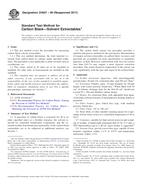Wir benötigen Ihre Einwilligung zur Verwendung der einzelnen Daten, damit Sie unter anderem Informationen zu Ihren Interessen einsehen können. Klicken Sie auf "OK", um Ihre Zustimmung zu erteilen.
ASTM D4528-88(2012)
Standard Classification for Rubber Compounding Materials—Sulfur
Automatische name übersetzung:
Standardklassifikation für Rubber Compounding Materials & mdash; Schwefel
NORM herausgegeben am 1.5.2012
Informationen über die Norm:
Bezeichnung normen: ASTM D4528-88(2012)
Anmerkung: UNGÜLTIG
Ausgabedatum normen: 1.5.2012
SKU: NS-27593
Zahl der Seiten: 3
Gewicht ca.: 9 g (0.02 Pfund)
Land: Amerikanische technische Norm
Kategorie: Technische Normen ASTM
Kategorie - ähnliche Normen:
Die Annotation des Normtextes ASTM D4528-88(2012) :
Keywords:
insoluble sulfur, rhombic sulfur, sulfur , Chemical analysis--rubber chemicals/materials, Classification (standards)--rubber, Insoluble matter content--rubber, Rhombic sulfur, Rubber compounding materials, Sulfur--rubber, ICS Number Code 83.040.20 (Rubber compounding ingredients)
Ergänzende Informationen
| Significance and Use | ||||||||||||
|
Sulfur is one of the principal rubber vulcanizing agents. It is a critical additive. When chemically combined with rubber, sulfur develops basic performance properties in the vulcanized compound such as: tensile strength, elongation, modulus, and hardness. In soft or elastic rubber compounds, sulfur is an essential but minor additive. In semi-hard rubber and ebonite, sulfur becomes a major compounding material while retaining its role as a vulcanizing agent. The most stable molecular form of sulfur at ambient conditions is a ring structure containing eight sulfur atoms. Depending on conditions these molecules orient into one of two crystalline structures. At room temperature the crystals are rhombic and above 95°C they rearrange to monoclinic. Less than 1.5 % of either crystalline structure of sulfur is soluble in any rubber at room temperature. The second common molecular form of sulfur is polymeric sulfur, made up of unbranched chains of sulfur atoms. It is commonly referred to in the rubber industry as insoluble sulfur. When this material is created by rapid heating to above 160°C and quenching to room temperature, the sulfur is amorphous. If formed under other conditions, the polymer chains may develop regions of pseudo crystallinity. Insoluble sulfur is an important form of sulfur used only in the rubber industry. It is not soluble in any type of rubber hydrocarbon. When it is mixed in rubber, it disperses but remains undissolved in the rubber. The use of insoluble sulfur prevents the development of a supersaturated solution of sulfur in rubber that occurs when rhombic sulfur is used. No sulfur bloom will develop on the surface of uncured rubber pieces when the rubber cools after mixing or processing; therefore, building tack is preserved. At curing temperatures, insoluble sulfur rapidly transforms to a soluble species, dissolves in the rubber, and enters into the vulcanization process. |
||||||||||||
| 1. Scope | ||||||||||||
|
1.1 This classification covers the variety of sulfur grades used in the rubber industry. Typical chemical and physical properties for sulfur are shown. Sulfur is principally used in unsaturated rubbers as a vulcanizing agent. |
||||||||||||
| 2. Referenced Documents | ||||||||||||
|
Ähnliche Normen:
Historisch
1.5.2012
Historisch
1.5.2011
Historisch
1.5.2012
Historisch
1.5.2012
Historisch
1.1.2009
Historisch
1.5.2012
Empfehlungen:
Aktualisierung der technischen Normen
Wollen Sie sich sicher sein, dass Sie nur die gültigen technischen Normen verwenden?
Wir bieten Ihnen eine Lösung, die Ihnen eine Monatsübersicht über die Aktualität der von Ihnen angewandten Normen sicher stellt.
Brauchen Sie mehr Informationen? Sehen Sie sich diese Seite an.



 ASTM D4315-94(2012)..
ASTM D4315-94(2012).. ASTM D4527-99(2011)..
ASTM D4527-99(2011).. ASTM D4569-06(2012)..
ASTM D4569-06(2012).. ASTM D4571-06(2012)..
ASTM D4571-06(2012).. ASTM D4573-03(2009)..
ASTM D4573-03(2009).. ASTM D4574-06(2012)..
ASTM D4574-06(2012)..
 Cookies
Cookies
